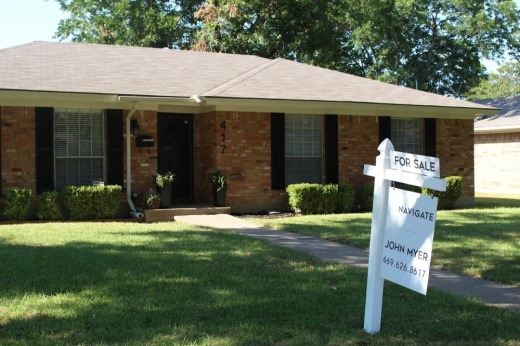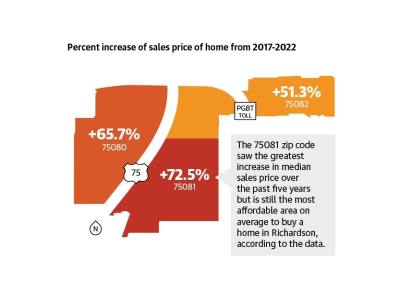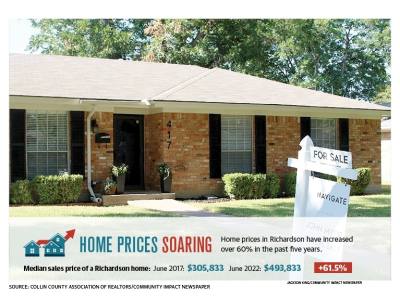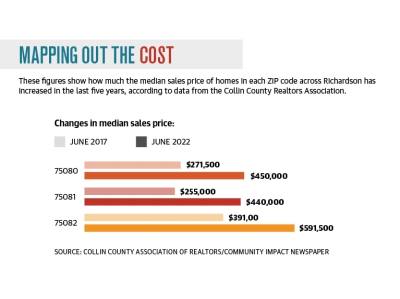Hunter Webb, real estate agent at Keller Williams Central 75 in Richardson, said low interest rates and a strong seller’s market in the past few years have led to homes being bought and sold at a faster rate, leading to dramatic price increases. He said some homes are being sold after being on the market for less than a month, rather than the typical two to three months.
But Webb said recently he has noticed the return to a more balanced market, where people are still able to sell homes while giving buyers more options. He expects further progress as sales continue to slow and prices begin leveling.
“As this market evens out, hopefully you’ll be paying closer to market value for the house,” Webb said. “Even though those interest rates may be rising, you’re going to be able to purchase homes at a more reasonable price.”
Lower home prices could help buyers as the average salary growth in Richardson has not kept up with housing costs, according to the latest data from the U.S. Census Bureau. From 2015-20, the average household income in Richardson increased by 17.8%.
Inflation and a recent economic downturn is another factor that could further reduce housing costs, according to Manasseh Durkin, chair of the Richardson Chamber of Commerce board of directors. With inflation rising and salaries remaining steady, he said Federal Reserve officials have begun to increase interest rates. Real estate experts believe higher rates could limit the ability of potential homeowners to secure mortgages, which would make it more difficult to sell homes.
“It is good for our houses to be valued high as an asset,” said Clinton Ball, president of the Highland Terrace Neighborhood Association. “However, the way the state and city value and calculate our taxes is increasing at an alarming rate, making it harder on many families.”
While this trend has increased home values for many residents, Ball said it has also created new financial challenges for some homeowners in the area. He described Highland Terrace as one of Richardson’s most desirable areas and said three houses have been sold in the neighborhood in the last 90 days. City officials have said high home prices can be beneficial to the community.
“When property values are strong, that’s an indication that the community is desirable and that the housing stock is well taken care of,” Richardson City Manager Don Magner said.
Market downturn
After the federal economy posted two straight quarters of negative growth, inflation across the country rose to 6.3% in May, according to a U.S. Department of Commerce Report. In response, the Federal Reserve Board raised its effective rates by 0.75%—the largest rate increase in nearly three decades, officials announced June 15. According to federal reserve officials, the rate increase will limit individuals’ borrowing power, which will impact their ability to file for mortgage loans.
Federal Reserve Chair Jerome H. Powell said during the June 15 announcement that another increase is up for further debate. Even before the interest rate increase, Webb said he had seen home buyers starting to be priced out of areas, such as Richardson, that are near Dallas. He said that has forced people to move farther north in the metroplex. Most of the sales price growth in Richardson has come from people moving in from outside of the metroplex, including from California and New York, according to Webb.
“Everybody’s kind of playing a game of musical chairs and trying to find where they can still afford to own a nice house and have a good life to raise their families,” Webb said.
A seller's market
A lack of new construction and housing projects have led to increased competition for existing homes, according to Webb.
“The pandemic brought construction to a halt, which made several cities unable to build homes to meet the demand for new houses,” he said.
Webb said the halting of construction ended up benefiting real estate agents tremendously as it generated more profit from selling pre-existing homes rather than newly built ones.
“A lot of these agents realized that they could sell $600,000-$800,000 houses and have better profit margins than building $200,000-$400,000 homes,” Webb said. “As a result, the product they were putting out there wasn’t necessarily for the first-time home buyers.”
Webb said buyers are now able to make a choice on where they live because of the shift toward working from home, which has given them more incentive to sell their houses.
“The days of having to choose where you lived based solely on your job are over,” Webb said.
Finding a home
Richardson is 96% developed with the remaining undeveloped land not being planned for housing projects, according to Magner. Still, portions of the city have been the focus of redevelopment projects, which have incorporated mixed-use developments with housing, retail and office elements. Projects being designed or under construction include the Belt+Main development, which will add 350 multifamily units and 7,000 square feet of resident amenities in addition to 15,000 square feet of restaurant and retail space.
Magner said these types of projects incorporate Richardson’s focus on “workforce housing.” This alternative to affordable housing projects is designed to be both cost effective and convenient for workers. The Belt+Main project and Dallas Area Rapid Transit’s Arapaho Station will combine retail shopping, dining and modern housing units, according to city officials.
“We are working with developers to create multifamily units that are smaller,” Magner said. “These units are cost effective for certain segments of the workforce.”
However, some residents have said multiuse developments can present issues for those living in traditional single-family neighborhoods. Ball said residents in the Highland Terrace neighborhood, which is located next to the Belt+Main development, are expecting to have noise and speeding issues once the complex is built.
“Highland Terrace has a big problem dealing with the increase in traffic volume,” Ball said. “We are very concerned about even more problems once the new apartment complex is complete.”
Potential market effects
The increase in interest rates is also expected to have a dramatic impact on the amount of homes being sold. Durkin said he has seen a large number of homes flooding the market in a rush to get ahead of the interest rate spike. Once interest rates rise, Durkin said homeowners should expect to lower asking prices to accommodate increased mortgage payments.
“Interest rates rising is going to suppress that house price and drive the market down,” Durkin said. “There’s either going to be less demand or you’re going to go find something that’s cheaper to meet the new monthly mortgage payment.”
Durkin said increased interest rates are often the first step in a market recession, which could impact the entire economy.
“Everyone should be concerned about it,” Durkin said. “I think we should put our minds together to determine what we can do to offer services and support the community as a whole.”










